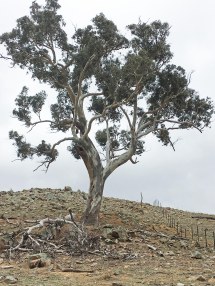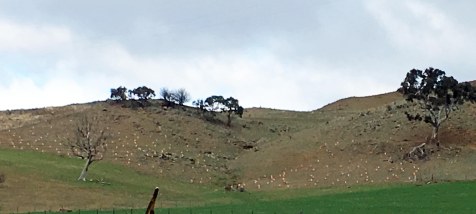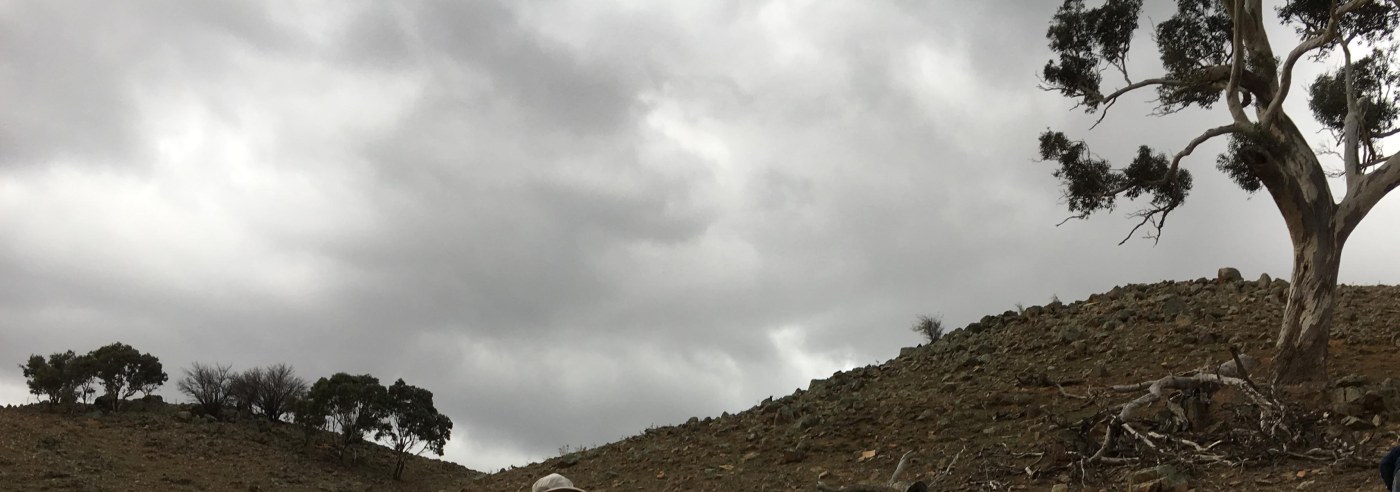After months of flu last year, I was very excited when Ben Hanrahan from Greening Australia offered help with planting our new Glossy Black Cockatoo area on the steep gully behind the house.
It’s been a dry year so far, with only scattered amounts of rain making the soil just moist enough for planting. Mostly we’ve had sunny days and warm temperatures.
We’d ripped and fenced and prepared for the arrival of the mystery volunteers. Ben didn’t say who they were, just that there were lots of them. But as we waited for the buses to arrive, the sunny morning began to sour. Matthew ran around putting rocks on each coir mat to keep them from flying away. The piles of pink corflute covers heaved and flapped against the heavy weights we’d put on them.
Looking at the surging clouds, Craig, Ben and Matt began digging some “demonstration” holes, to shorten the planting process.
Then the rain came down, just as the two big buses arrived.  The lovely volunteers from ThinkPlace were instantly soaked despite raincoats and plastic ponchos, but gamely set about transporting food and drinks up to the verandah of the house. All concept of having lunch out in the paddock was abandoned, but the crew was lively and willing to give some planting a go.
The lovely volunteers from ThinkPlace were instantly soaked despite raincoats and plastic ponchos, but gamely set about transporting food and drinks up to the verandah of the house. All concept of having lunch out in the paddock was abandoned, but the crew was lively and willing to give some planting a go.
Ben explained the Glossy Black Cockatoo program, where allocasuarina verticillata (drooping sheoak) that have gone missing from the landscape are being replanted to allow these small black cockatoos to move around the landscape again. I gave a short explanation of what we’re trying to do at Esdale and Adnamira, including encouraging biodiversity and resilience in the landscape while still maintaining a productive sheep farm.
 I also really want to protect and preserve the big remnant trees we do have, some of which could be up to five hundred years old. They desperately need understorey plants that will protect the birds that then eat the insects that destroy the trees. One of our most beautiful Blakely’s red gum trees is in the area we were planting.
I also really want to protect and preserve the big remnant trees we do have, some of which could be up to five hundred years old. They desperately need understorey plants that will protect the birds that then eat the insects that destroy the trees. One of our most beautiful Blakely’s red gum trees is in the area we were planting.
Having cowered under shelter through what we hoped was the worst of the weather, we all headed up to the gully for planting demonstrations (almost drowned out by the flapping noise of plastic ponchos), and then let the volunteers loose. The rain returned, with more wind, covers flying across the hill and having to be chased down, mattocks swinging energetically as more holes were dug, each plant gently separated from it’s tube, planted and protected.
I took to making covers, keeping my foot on the pile while shoving stakes through the holes. They wrestled in the gusts, occasionally flying back to spreadeagle against the fence. Usually, that’s the easy job.
When the sleet began, the amazing crew was already two thirds of the way across the hillside. I worried that if we went on, we’d lose people to hypothermia, but they had their heads down and fought up the other side of the gully toward the fence.
After another twenty minutes or so, Ben decided things were getting too dangerous, and we went back to the house to eat the lunch (out of the rain). At that point most people were chilled and willingly headed back to the buses to go home, but a small crew went back and finished the last dozen when the rain let up slightly.

I was frankly amazed that we got 240 trees planted on steep, rocky ground under those circumstances. Thank you ThinkPlace (and Greening Australia) for dealing so well with our unthinkable weather. 



Allocasuarina verticulata: such a beautiful tree. How does something like this just disappear from the landscape? Thanks to all involved in this work. We are doing something similar in the Wingecarribee area with a program called Glossies in the Mist
LikeLike
Glad to hear about your Glossies in the Mist project. When I’m standing on the top of a hill looking north and south, it’s powerful to feel part of the Great Eastern Ranges. I guess you’re far enough west not to have casuarina littoralis?
Verticillata disappeared here because it relies on frequent re-seeding and a short (40 year) life span. When sheep arrived they ate the seedlings, and after a few rounds of seedlings, there were almost none left. We did find a few in rocky spots, which we’ll try collecting soon. Until recently we didn’t know they were different from the prolific river casuarinas along the waterways (Cunningham’s), which shoot up much faster and get ahead of the sheep.
Now we just need to spot some glossies…
LikeLike
Sleet, that’s intense. Very interesting post.
LikeLike
Ooh, it was. Mind you, I was complaining much more than our volunteers. I’m such a wuss.
LikeLike
Hi Fiona, what a day! but incredible what you are achieving. Regards, Barrie
LikeLike
Thanks Barrie. This has been a really lovely area to plant in (despite the rocks). The views of the river are spectacular (when the fog goes)
LikeLike